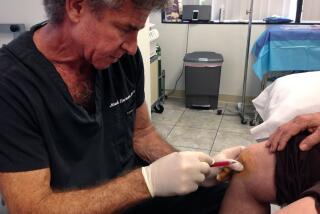Column: California moves against unlicensed stem cell treatments — but is it doing enough?
On Oct. 2, California took a major step to address an emerging public health crisis. That’s the day Gov. Jerry Brown signed a law imposing the first regulations in the country aimed at direct-to-consumer marketing of unlicensed, unproven — and sometimes disproven — stem cell “treatments.”
These treatment clinics have metastasized nationwide; roughly 600 were identified last year by UC Davis cell biologist Paul Knoepfler and University of Minnesota bioethicist Leigh Turner. As befits a place that always has been fertile ground for entrepreneurs, scrupulous or otherwise, California hosted the largest number, 113. Knoepfler and Turner are certain that the number is considerably larger today.
As we’ve reported, the clinics often list conditions such as Alzheimer’s, Parkinson’s, multiple sclerosis, diabetes, and cancer among the conditions they can treat — for prices in the thousands, uncovered by insurance, without providing any scientific evidence that they work.
Unlicensed stem cell treatments aren’t innocuous — some have resulted in permanent injury to customers. Among other cases, three elderly women were reported this year to have lost all or part of their vision after a “stem cell” solution was injected into their eyeballs at a Florida clinic to treat macular degeneration. And bogus stem cell treatments can distract patients from pursuing traditional therapies that might actually work.
There aren’t any checks and balances for this new evolving healthcare delivery system. There’s no oversight whatsoever.
— State Sen. Ed Hernandez, sponsor of a first-in-the-nation law regulating stem cell clinics
California’s law, which takes effect Jan. 1, covers any clinic offering stem cell treatments not approved by the Food and Drug Administration. That’s essentially all of them, since the FDA has only approved one treatment, which uses cells derived from umbilical cord blood to treat “certain blood cancers and some inherited metabolic and immune system disorders.” The clinics will have to post notices in their offices, including at the entrance, reading as follows:
“This health care practitioner performs one or more stem cell therapies that have not yet been approved by the United States Food and Drug Administration. You are encouraged to consult with your primary care physician prior to undergoing a stem cell therapy.”
The print must be close to a half-inch high or larger and the same statement must be handed to the customer separately before treatment begins. After the first violation, subsequent failures to comply are subject to a fine of up to $1,000 per incident.
The law also instructs the California Medical Board to compile statistics on complaints and disciplinary or administrative actions taken against doctors working with stem cell clinics, starting next year.
In many ways, this law is a good first step at putting these clinics on a regulatory leash. “When I started hearing about what’s going on with stem cells, I realized there aren’t any checks and balances for this new evolving healthcare delivery system,” the law’s sponsor, state Sen. Ed Hernandez (D-Azusa), told me. “There’s no oversight whatsoever.”
Some experts think the new law is a worthy advance. “It’s the only law that ensures there’s disclosure” that the nostrums being offered aren’t approved or licensed by the FDA, says Beth E. Roxland, a bioethicist at New York University’s medical school. “That alone is a big positive.”
Knoepfler believes the disclosure could be a useful counterbalance to what he told the Senate Business and Professions Committee earlier this year is “all the buzz around stem cells,” especially among customers who may be on the fence about pursuing the treatment. He also hopes that California’s initiative might encourage other states to “jump on the bandwagon” of regulation.
Yet there’s reason to ask whether California’s law goes far enough to regulate businesses exploiting the desperation of patients with intractable diseases.
Start with the wording of the required notification, which refers to treatments that have “not yet” been approved by the FDA. This suggests that FDA endorsement may only be a matter of time — that the treatments may be premature, but not fictitious. That’s wildly optimistic and may itself foster a false hope for the treatments.
The law also imposes enforcement responsibility on one of the state’s most reluctant regulators, the California Medical Board, while failing to give the board any new resources. It’s unclear how clinics’ compliance is to be verified; the medical board almost certainly doesn’t have the money or staff to perform spot-checks to make sure the appropriate signage is posted and notifications handed to patients. The board seldom takes a proactive approach to its oversight — it responds to complaints filed against physicians by patients or fellow doctors.
The rise of the direct-to-consumer business model in stem cell treatments flows from the confluence of two alarming and dangerous trends in healthcare. One is the penetration of nonscientific claims into medical practices, abetted by established institutions risking their reputations by accommodating “alternative” medicine to build their business base and funding endowments. (We’re looking at you, UCI.) The other is the “right-to-try” movement, which aims to give sufferers of intractable or incurable conditions the opportunity to sample almost any last-gasp therapy without interference from government regulators.
The right-to-try movement is now supported by laws in 36 states. In mid-June, Texas Gov. Greg Abbott signed a bill adding “investigational stem-cell treatments” that could be accessed by patients with “severe chronic diseases or terminal illnesses” without interference from government officials.
The measure specifies that the treatments must be overseen by an institutional review board associated with a medical school or hospital and performed at a medical school, hospital, or ambulatory clinic. But Roxland doubts those provisions are going to provide much protection for consumers in Texas, which trails California only narrowly in its number of stem cell clinics.
“I could poke ginormous holes in the Texas law,” Roxland says. Among other shortcomings, “it doesn’t say the treatment has to be in an FDA-blessed clinical trial or even a U.S. trial.”
The proliferation of direct-to-consumer stem cell clinics has unnerved medical regulators and legitimate stem cell scientists. A group of FDA officials warned last March in the New England Journal of Medicine that the claim that stem cells can somehow “sense the environment into which they are introduced and address whatever functions require replacement or repair … is not based on scientific evidence.”
In a 2015 article in the same publication, Hermes Taylor-Weiner and Joshua Graff Zivin of UC San Diego sounded a similar alarm that misleading publicity and a lack of regulation had created a “wild west” of unlicensed stem cell clinics.
“Although stem-cell therapy may hold great potential, the field is less advanced than the public has been led to believe,” they wrote. “Stem-cell clinics in the United States and abroad have capitalized on this confusion.” That’s an indication that laws like California’s are overdue.
The most common procedure offered by these clinics involves liposuctioning fat cells from the customer, subjecting them to some mysterious manipulation ostensibly to extract stem cells from the tissue, and reinjecting them into the customer’s body. That has not been shown to have any effectiveness whatsoever and isn’t in the mainstream of stem cell medical research. Whether the clinics even perform the processing they claim to do isn’t easy to verify.
Minnesota’s Turner asks why businesses claiming to offer treatments with no evidence of efficacy against Alzheimer’s or spinal cord injuries should even be allowed to operate. He suspects that the notification requirement won’t bother many of the businesses — many already post on their websites FDA disclaimers that just get glossed over by consumers desperate for a cure.
Hernandez acknowledges that his measure is just a first step. “Because it’s so new, we’re trying to figure out the best way to start the conversation,” he says.
But lawmakers and regulators may need to move faster. What will make a difference in California may not be how the conversation starts, but where it leads.
Keep up to date with Michael Hiltzik. Follow @hiltzikm on Twitter, see his Facebook page, or email [email protected].
Return to Michael Hiltzik’s blog.
More to Read
Get the L.A. Times Politics newsletter
Deeply reported insights into legislation, politics and policy from Sacramento, Washington and beyond. In your inbox three times per week.
You may occasionally receive promotional content from the Los Angeles Times.











